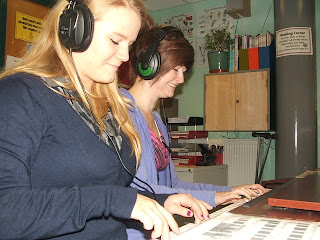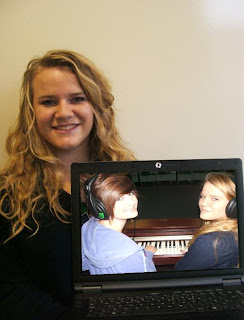
For this shot, I decided to change my angle entirely. I thought, by using an angle where the piano is involved and my two individuals are clearly also present was effective. Despite using a flash for this image, I thought it looked good, and did not matter as much as before as it was not the main image.

This is the shot I began with when I was trying for my 'laptop' image (the image I wanted to put on the laptop screen using Photoshop. I liked the angle I used in this shot, although the image was not as naturalistic as I wanted. Also, I thought the image was too 'busy', and this would not be a very clear image when I made it smaller to fit the laptop screen.

This is the image I chose as my final front cover. I used this one as I was very happy with many things, for example the closeness of the shot, the angle of the laptop and the size of the laptop compared to the amount of my subject showing. In hindsight, I would of preferred an outside image, meaning I would not have needed flash; therefore the lighting would have been better. Additionally, I would have considered having my subject wear a different coloured top, as this would have meant the image did not look too dark.

This is an earlier shot of my subject that i did. Even though i was pleased with the result, I felt the laptop angle was wrong, and there was a flash on the wall. Also, I felt the shot was slightly too close, and the laptop was overpowering, with not enough of my subject.
Preliminary Task: Provisional SubmissionAudience:
Who is your primary audience?
My primary audience is students between the age of 11 and 18, teachers and parents.
What does your student magazine offer as its main 2/3 uses?
My magazine is there to inform anyone associated with the school (primary audience) of the latest news that has happened recently. My magazine mainly offers help and advice to students who are planning their life beyond year 11. The magazine would offer support and advice on where to find this information, offering opinions from staff and sixth form students. The ideas available would be sixth form, college, going into work or an apprenticeship. My magazine also offers revision tips, for students who are preparing for any exams from class tests to main exams like GCSE’s and A levels. Lastly, my magazine would be intended to keep students and their families up to date with the latest developments on the school, as these are always happening or being planned. Doing this would be an effective and efficient way to keep the readers together with the goings on of the school.#
Image:
What will your medium close-up subject be?
I have many ideas as to what would make an effective school magazine front cover. I liked the idea of having my subject covering 2/3 of the page, and looking straight at the camera. The student would be looking keen and happy. My main idea would be for a student to be holding an object where I can use Photoshop to incorporate another image onto. I am as yet indecisive over what object I will use, however I was considering a white-board, a window pane, a laptop or a book. This will possibly be a hard look to achieve, as I am under the criteria of it being a medium close-up, so to be able to include a second image will be a challenge. I would like to use a simple background so the reader won’t be distracted away from my subject. I would like to base the magazine’s colour scheme on that of the school’s, i.e. dark blue, purple, gold and yellow, as this would be effective and mean the magazine was recognizable as being for Sheldon School.
Text:
Your front cover must contain ‘appropriately laid out text and a masthead’ – what will this consist of?Title: I have chosen a few names for the title of my magazine. These being: ‘Sheldon Specials’, ‘Sheldon Star’ and ‘Sheldon Weekly’. I particularly like the idea of ‘Sheldon Specials’ and ‘Sheldon Star’, as both of these use positive words which connote a positive message about the school, i.e. ‘special’ and ‘star’. I would like to use Verdana font as this is easy to read, and mature. I am considering either dark blue or black font colour for my title, as these are both bold colours which would enable the title to stand out on the page. The title would be typically situated at the top of the page, positioned slightly to the left. It would also include a slogan, which will overlap the title slightly.
Sell-lines: These would include revision tips to help the students and for parents to advice for their children, and information and help on life beyond year 11. It would also include other articles on the schools food, upcoming events in the school, and information on how to have ‘your say’.
Interior features: These would be based around the sell-lines on the front cover, and what is featured in the contents page of my magazine. They would be interesting features that would hopefully appeal to students, parents and teachers. For example, I was considering a page to fill in your ideas on what to do for upcoming fundraising events or new afterschool and lunchtime activity clubs.












